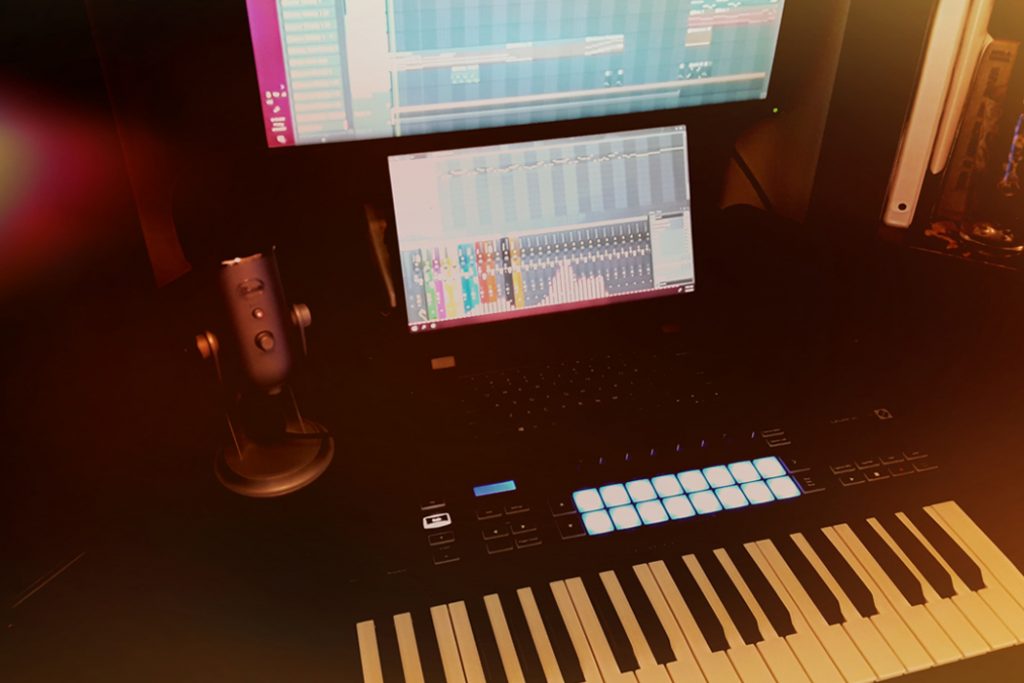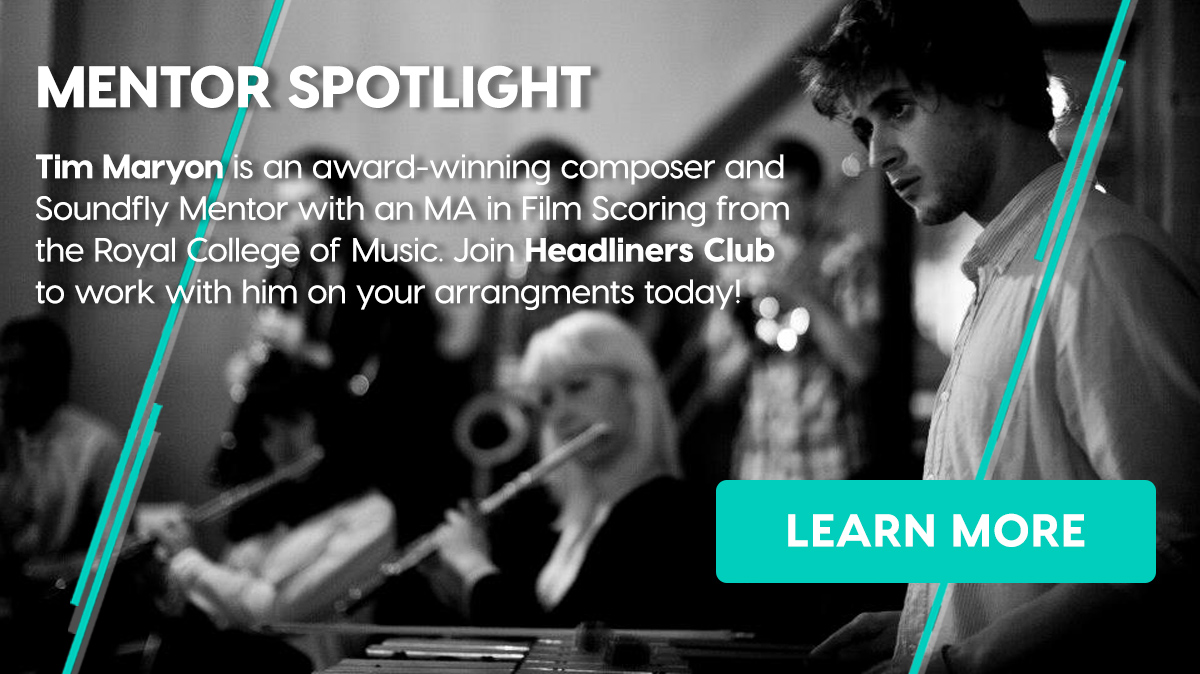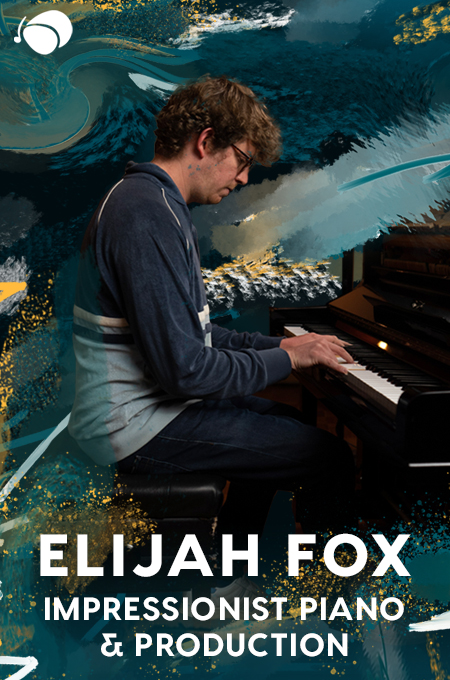
This interview was conducted with Kevin Gundlach, a composer, producer and Soundfly community member, highlighting and exploring music he made for an exciting new roll-playing game and discussing his recent Soundfly mentorship session.
For this latest edition of our Student Spotlight series, I chat with Soundfly community member and composer, Kevin Gundlach about his recently debuted score, created to serve as an atmospheric backdrop to a forthcoming roll-playing game (RPG) called Desert Moon of Karth. The object of the game has been described as follows:
“A space western sandbox on a tiny moon for Mothership RPG. Harvest the ossified corpses of coral beings and live forever.”
This game sounds, in a word, AWESOME. And so does the music (so far). I mean, just listen to this gnarly Morricone-esque stingray of a song:
The best part about all of this is that I found out about Kevin’s RPG scoring project on Soundfly’s community Slack forum, which is one of the best perks of our all-access subscription. Not only can you take every online course we offer, you get to hear music from all over our community, network and collaborate, and get feedback on your work from your peers.
We dig into all that and more.
Q: I’m personally a huge fan of Ennio Morricone’s orchestral score work, Sergio Leone’s films, and Cowboy Bebop, which I know was a point of inspiration for your team as this music is incorporated into a “space desert western” themed game (more on that below). Let’s talk about “Sundown Getaway” — can you describe the feeling of this track? And how did you land on the arrangement elements of it?
A: I would say that the feeling for this track is very much a “Finale” ending type track. When writing this I envisioned a cowboy main character on his horse (or space-horse?) riding into the sunset, after just defeating the bad guys. The story is over, the hero won. They “did it.”
There were a couple main motivators for this track. One motivator was the music played for the Season 4 finale of Breaking Bad. I tried to capture not necessarily the instrumentation, but rather the feeling of “Finale,” like “wow something epic just happened, and now we’re riding into the sunset.” When I write music I try to set a feeling for what I am going for beforehand. This allows me to keep my vision focused and gives me a clean goal for the emotions I want to express.
Another one of my main inspirations for this track was Ennio Morricone’s Theme to For a Few Dollars More. Specifically, the ability to “repeat” elements while adding a slight twist to them. When researching this music, Soundfly’s own article on Morricone’s composing techniques came to great aid here. I tried to bring in techniques such as a pulse, triad ostinato, and the human voice as a rhythmic instrument.
- The pulse comes from the bass drums (doubled by a contrabass), along with a bass guitar playing the chord roots beneath.
- The triad is being played by an electric guitar in the background (as first heard in the beginning).
- The human voice is a rhythmic instrument I add in a couple places to “spice it up” and add a bit more of a Spaghetti Western feel. It’s used sparingly in this song, but it is something I want to make more use of later on.
Additional elements I used were an ocarina and human whistle. These add a lot more to the folky feel, to try and achieve that Spaghetti Western texture.
“When I write music I try to set a feeling for what I am going for beforehand. This allows me to keep my vision focused and gives me a clean goal for the emotions I want to express.”
When you compose and work on Western music, what’s your process like? What comes first and are you ever using reference tracks?
Oof, this is a bit of a hard one, because my process changes a lot. Generally when it comes to Western music like these songs though, I try to come up with a chord progression first, as opposed to a melody first (which is what I’m used to doing). Once I have the chord progression, I add bass, and melody, until I have a lot of pieces I can play around with, and try building a song.
Before I did any of that though, I made an “orchestra” of Spaghetti-Western esque instruments. This included a “gallop” guitar, strumming guitar, melody guitar, flute, bass, and drums. There was a bit more to this part, because I had to turn my virtual instrument guitar (Shreddage) into a Spaghetti Western twang guitar. The virtual instrument came with a “Surf” preset. In order to turn this into a Spaghetti Western guitar, I added tremolo (through a virtual amp), and added some wide plate reverb. This ended up creating a wide sound stage that helped contribute to the Spaghetti Western guitar sound. I used For a Few Dollars More as a reference for choosing a good sound.
After I had my instruments, I began doing the rest.
The chords: In the case of “Sundown Getaway,” I wanted to choose a chord that described the feeling of “icy.” For me, this chord was a B minor in second inversion with a D on top. The reason that I chose an “icy” feel is, to an extent, because I think that’s what being a bounty hunter “hero” might feel like after what they’ve done. You’ve stuck it to the bad guys in the cave, and now you have to ride off, and have no regrets. You can’t go back and try and resolve what you did peacefully, it’s done now. So stay strong, and ride off.
From there, the chord progression was further developed by playing with different chords, and seeing what possibilities I could come up with, until I chose one that fit. This was done by using a note in the original chord as the tonic, and playing different chords in that key (or borrowing chords from others) until I had a progression with tension and release. Technically I just tried to make a chord progression that felt strong and confident.
The bass line: Next, I made a bass line and pulse from those chords, with the bass playing the first and fifth notes of each chord in a pulse manner ( 1 2 1 2 ).
The melody: Lastly, I made a melody and countermelody that was in harmony with the chord progression. When it came to making the melody, I tried to keep it simple, mainly playing notes within the chord. In For a Few Dollars More, I noticed that while the whistle/ocarina played the melody, there were bits and pieces of melody played by the guitar. I wouldn’t call it an entire melodic phrase, but definitely “pieces” of the melody, playing notes from the chord in an interesting rhythmic fashion. Then, I added a countermelody using my “flute” instrument.
Once I have all of these pieces as “patterns,” I play around until I have a structure. I will add variants of each of theses in order to further progress the ideas.
“Wailer in the Dunes” definitely has a different tone than “Sundown Getaway;” it’s forward driving and exploratory, much more open-ended, but there’s also a character trait in that violin with a sense of longing to it. Do you utilize character voices in your instrumentation?
Yes, definitely! This piece tries to tell a story, structurally, about the search for a haunted locket.
The strings at the beginning were very much meant to represent the ghost or “wailer” that haunts the locket. I suppose it sounds longing because I mean, you’re a ghost, you’re probably longing something if you’re still around (at least, that’s really what I had in mind when writing). Perhaps the ghost is lurking for revenge, or to terrorize cowboys who seek its haunted locket — whereas the guitar playing the melody is the theme of the adventurers who are seeking the locket.
Certain instruments are used to add to the texture, as well. The long strums of the guitar are meant to add to the wide open “desert” atmosphere. In addition, the rattling snares are meant to be a texture simulating horse hooves. As tension builds towards the end of the song, they go from a soft walk to a fast gallop as the imaginary scene erupts into a battle with the ghost.
Where do you find inspiration for your music in general?
Honestly, a lot of my inspiration generally comes from vintage film and cartoon music. I think there’s a lot of classical influence in that type of music, but it’s also got a lot of expression to it. I like music that has a textured world that you can imagine along with it, like in Indiana Jones, Star Wars, or in soundtracks like in Cowboy Bebop.
Music, in my opinion, plays such a vital role in world-building because of the complexities you can express through it. For instance, in Indiana Jones you feel the atmosphere of mysterious temples through woodwind chord modulations, or the intimidating power of a space fleet through the use of big brass. It is things like this that inspire me, the various ways that you can express a world through texture.
Let’s talk about the game itself. I’ve definitely listened to a ton of video game music, and that’s quite a lucrative path for musicians who understand the sound design and narrative scoring aspects of that world, but I’ve never heard of “music for role-playing games.” Is this common in the RPG world? Where did the inspiration come from?
Although it might not seem like it for tabletop, music can play a role in immersing players, similar to what you would hear in a video game. While it is up to players how they would like to use the music, the general “idea” of having the music available is to allow the DM (dungeon master) to be able to play music in order to immerse players in the new zone.
*Note: The music in the above trailer was created by When the Coyote Eats the Rat.
The idea of the music is to provide inspiration for a roleplay. For instance, if you’re in an old mine, perhaps hearing an odd noise in the ambient music could lead the roleplayers down the path of finding a mysterious object, in the cave. From there, perhaps this mysterious object grants an odd power to the players, or it has a boss fight behind it. It is to add a slight boost to the player’s immersion, and inspire possible stories or character development for the players.
Another idea that we may or may not implement, if we have time, is make several different “variants” of the existing songs, to allow for the dungeon master to have more control over the mood. This way, you can play low-intensity versions of the music when the mood is passive, and a high-intensity version of the music when it is a battle.
“Music, in my opinion, plays such a vital role in world-building because of the complexities you can express through it.”
So, the players will be listening to this “score music” alongside their efforts in gameplay. How do you see users playing the game alongside the music?
If I were a player, I might like to listen to the soundtrack in the background, and maybe throw our soundtrack, and a couple of Spaghetti Western songs into a playlist, too. As a dungeon master, I might play the songs as an introduction to the area that the players are playing in, or to set a mood. For instance, you could play “Sundown Getaway” if your players just defeated the bad guys, or “Wailer in the Dunes” if the players are searching for something mysterious.
Congrats on getting funded via Kickstarter to make Desert Moon of Karth, when do you expect to launch?
It’s going to launch in late May!

So, what brought you to Soundfly originally? And what made you stick around for such a long time?
There were a couple of things that brought me to Soundfly. First, I really liked the genuineness of all of the articles here on Flypaper. There’s tons of resources to read, and I really liked the attitude and positive approach to learning. I feel like it’s an amazing resource no matter what genre of music you’re making.
In particular though, I love the community on Slack. It’s a positive learning community that I can share my thoughts with, and there are many talented people there with things to share about their experience. Plus, everyone is super friendly. To me, it’s very similar to going to a school, and I like Soundfly because it’s a place where I feel free to create.
A little while ago you worked with Tim Maryon in a Soundfly mentor session, how was that experience for you, and have you used Tim’s advice and feedback since?
That was a fun experience. Tim gave me an expansive introduction to the world of what professional film-scoring is like using a DAW, and he taught me the sorts of questions composers will ask when analyzing music they like. For instance, “Where does the snare come in? How are the instrument sections structured?” These types of questions may seem trivial now, but I did this session with Tim when I was about six months into making music, and it was nice to have direction on precisely what to look at.
Tim also taught me about the importance of sketching, which I still do (and actually did for “Wailer in the Dunes”). A sketch can come in many different forms. Sometimes I will sketch by coming up with the story that I want the song to tell, before hand. Or, I will make a sketch using chords, or instruments.
I stopped making sketches for my pieces for a while, because I thought “ehh I’ll just feel my way through it.” But frankly I’ve found that if I don’t use sketches, often the structure of my piece sorta goes nowhere. Not all the time, but enough that it irks me. I might be able to make an eight-bar part that sounds great, has good instrumentation, harmony, but from there it’s often a guessing game in terms of where I want to go with it. In contrast, when I do sketch, I know where I want to go, which helps me with my structure.
Who’s a peer in your life has been a major influence on your music making?
In addition to Tim, there’s a certain special individual who I met on Discord, who really helped “ground me” when it came to helping me learn the music theory fundamentals. This was Ben Mildenberger.
Ben sat down with me for several hours a day, helping me work through the music theory of my pieces. That is, we would look at what sort of harmony I was implying in my pieces, and he showed me how I could use theory to make a few small tweaks to my chords in order to yield a sound that was a lot more cohesive, and really pretty. He also helped me learn what a melodic structure looks like using phrases/sentences.
I used to not really consider much music theory before, I would always just sorta go for a I and V chord and put whatever in between, but even then, I didn’t really want to use a lot of theory because I didn’t want my music to sound the same as everything else. But the truth is, I’ve found that music theory can help fill in the gaps where my inspiration fails me, and it can help enhance musical ideas. Ben showed me that music theory isn’t so much of a specific ruleset you need to follow all the time, but rather that music theory is a toolkit you can use to yield some pretty amazing sounds.
I think being able to get advice from someone, or having someone look at my music with me constructively, has really helped me figure out what my shortcomings are, while also helping me expand on my strengths. This has helped speed me along in my learning faster than if I went at it entirely alone.
Ready for a custom session of your own?
Soundfly’s community of mentors can help you set the right goals, pave the right path toward success, and stick to schedules and routines that you develop together, so you improve every step of the way. Tell us what you’re working on, and we’ll find the right mentor for you!





